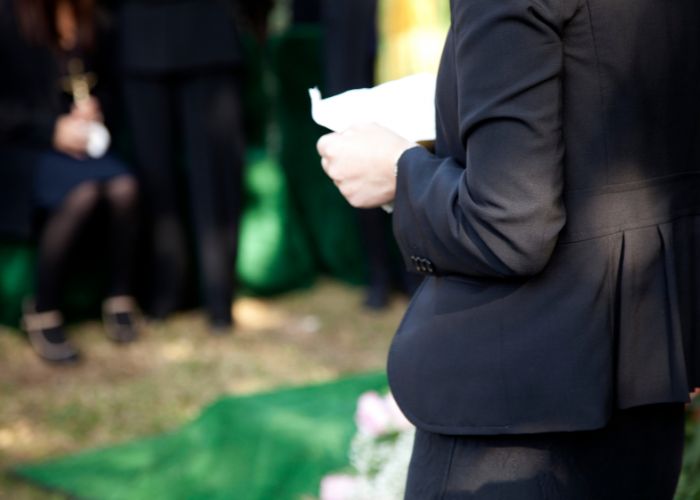Every life lived tells a story, and a eulogy serves as a heartfelt tribute to the one who has passed. It is a moment to share experiences, talk about love & celebrate the essence of loved ones. In the middle of the whirlwind of preparation for a funeral, it’s natural to feel overwhelmed.
The moment of a eulogy can be a symbol of a very painful time, as we say our final goodbyes to a loved one. However, it is also a moment where we can find healing in remembering their life and the good memories we shared together. Every life lived tells a story, and a heartfelt tribute can serve as a beautiful celebration of the essence of those we have lost. Even in the midst of the whirlwind of preparation for a funeral, we can take comfort in the memories we hold close to our hearts.
This article, focusing on “how to write a eulogy,” will share with you some valuable eulogy writing tips, guidance, and examples so that your journey through this delicate process becomes easier.
The art of writing a eulogy requires a blend of storytelling combined with empathy & sincerity. In this comprehensive guide, we will delve into the various aspects of creating a memorable eulogy.
We will start from the initial brainstorming stage to the final polished speech. Key topics we’ll explore include how to start a eulogy, finding the right tone, and incorporating anecdotes to make your eulogy resonate with the audience. Along the way, you will also find inspiration through eulogy examples and techniques.
As we start on this journey you should remember that the ultimate goal is to celebrate a unique life. Through your words, you will be leaving a lasting impression that will bring solace and comfort to those who grieve.

Preparing to Write a Eulogy
The process of preparing to write a eulogy is essential, as it not only helps you pay homage to the deceased but also offers solace to the grieving. To make it a genuinely heartfelt and meaningful tribute, invest time in gathering your thoughts and finding emotional and mental equilibrium. In this section, we’ll explore ways to navigate the complexities of eulogy preparation for a funeral.
First and foremost, acknowledge the gravity of the task at hand, and give yourself permission to feel the emotions that may arise. This introspection is crucial in crafting an authentic and poignant eulogy. As you embark on this journey, consider the following techniques to help you navigate the process:
Reflect on the person’s life and personality by creating a chronological timeline of significant events. This could include milestones like graduations, marriages, the birth of children, and career achievements. A well-structured timeline will provide a natural flow for your eulogy, making it more relatable to the audience.
To emphasize the unique traits of the deceased, develop a word cloud of adjectives and phrases that capture their essence. This exercise will not only help you to articulate their characteristics but also jog your memory to recall anecdotes that illustrate these qualities.
Assemble a mood board to evoke the spirit of the person’s life. Combine pictures, quotes, milestones, and significant locations that capture their essence. This visual compilation will inspire themes and messages that resonate throughout your eulogy, providing structure and coherence.

Writing a Eulogy
Crafting a meaningful, and memorable eulogy is a delicate task. It demands thorough and very thoughtful considerations. With these eulogy writing tips, you’ll be able to write a beautiful eulogy and to honor the life of your loved one in a beautiful way.
Building the eulogy
A eulogy typically consists of an introduction, body, and conclusion.
Introduction
In the introduction, present yourself and explain your relationship to the deceased, establishing a personal connection with the audience. This sets the stage for the stories and reflections you’ll share throughout the body of the eulogy.
The body
In the body, focus on weaving together anecdotes, memories, and personal details that encapsulate the essence of the person you are eulogizing. Delve into their background, discussing family ties, friendships, and significant milestones.
Highlight their passions, values, and philosophies, showcasing how these shaped their life and influenced others. Remember to consider the tone, ensuring it aligns with the individual’s personality and the atmosphere of the memorial service.
When recounting anecdotes, don’t shy away from incorporating humor or lighthearted moments if appropriate, as these can provide solace amid grief. However, be mindful to avoid topics that may alienate or discomfort the audience, such as the cause of death, unresolved conflicts, or unflattering stories.
Conclusion
As you approach the conclusion, take the opportunity to summarize the person’s legacy and the impact they left on their community. Offer words of comfort and gratitude, acknowledging the support and presence of those in attendance. This helps to create a sense of unity and shared healing.

Examples of Eulogies
Looking at eulogy examples can unquestionably offer a wealth of inspiration and guidance when composing a heartfelt tribute to the dearly departed. The benefits of perusing various eulogy examples are manifold; they not only provide you with a glimpse into diverse writing styles, but also demonstrate the potential of evocative anecdotes to create a poignant narrative.
Reflecting on eminent eulogies, consider President Barack Obama’s stirring address in honor of Nelson Mandela, where he underscored Mandela’s impact on the world. Another compelling eulogy was delivered by Steve Jobs’ sister, Mona Simpson, in which she recounted personal memories and the many facets of Jobs’ life. Similarly, Earl Spencer’s tribute to his sister, Princess Diana, beautifully encapsulated her spirit, grace, and legacy.
While examining these eulogy examples, absorb the unique essence of each, noting the harmony between vulnerability and strength, the intertwining of humor and gravity. Such eloquent eulogies serve as a reminder of the importance of celebrating the life lived. They acknowledge the profound loss experienced by those left behind.
In the end, let these eulogy examples guide & inspire you, as you craft your own deeply personal & heartfelt homage: honoring the memory of the one who has passed on. Remember, a eulogy is a chance to recount shared experiences and celebrate a life well-lived, in a tone that is respectful, somber, and conversational.

How to Start a Eulogy
Initiating a eulogy might feel daunting, especially considering the intense emotions permeating the atmosphere during such an event. When pondering how to start a eulogy, remember that the best approach is to compose yourself and prepare thoroughly. As you embark on this emotional journey, consider these helpful tips to effectively begin your eulogy.
1.Firstly, always ensure that your eulogy has been thoughtfully prepared ahead of time. Even if you’re an experienced public speaker brimming with anecdotes, the emotionally charged setting can make it difficult to articulate your thoughts precisely. Writing out your speech and practicing aloud will bolster your confidence, allowing you to deliver your message more effectively.
2.There are various methods to commence a eulogy, and choosing one that resonates with you and the audience will help set the tone. Opening with a personal story about the deceased can create an emotional connection with listeners, highlighting the individual’s unique qualities or showcasing a memorable moment you shared. This approach allows the audience to reminisce, laugh, or even shed a tear together.
3.Another tactic for starting a eulogy is to recite a poignant quote or a poem that captures the essence of the departed. This strategy not only conveys your feelings but also offers a moment of reflection for the mourners, illustrating the impact of the person’s life on others.
Regardless of the method you choose, always remember to consult someone you trust, preferably someone acquainted with the deceased, to review or listen to your speech. Their input can help refine your ideas, ensuring that you’ve chosen the most appropriate stories and included essential details.
How to End an Eulogy
As you reach the conclusion of your eulogy, it is essential to leave your audience with a lasting impression of respect and admiration for the departed. A typical eulogy comprises 500 to 1,000 words, taking approximately three to eight minutes to present.
Ensure you communicate with the funeral director or the memorial service organizer to determine the time allowed, adjusting your speech accordingly. Practicing aloud is vital to gauge the pace and length, enabling you to deliver your speech with clarity and confidence.
In the finale of your eulogy, an impactful approach is to express gratitude towards the deceased. Offer thanks for their achievements and contributions, bidding farewell on behalf of yourself and others who have been positively influenced by this extraordinary individual. This dignified and respectful expression will lend a heartfelt touch to your closing remarks.
It is crucial to maintain an optimistic tone when concluding a eulogy. Your words should inspire hope and uplift the spirits of those present, encouraging them to emulate the exemplary character of the deceased. By fostering community connections and cherishing shared memories, the memory of the person will continue to thrive. Ultimately, your eulogy should evoke feelings of fondness and appreciation in the attendees, honoring the life of the departed.

Conclusion – How to write a Eulogy
We hope that the tips shared with you gave you some inspiration on how to start crafting a heartfelt eulogy for your loved ones when preparing for the final farewell. Remember to take time out, and recollect anecdotes and memories of the departed one. Establishing a timeline is always helpful.
You can always start the eulogy with a quote or an anecdote, and end it on a positive note. If you need help in writing the eulogy, you can ask for it from your friends and family.


